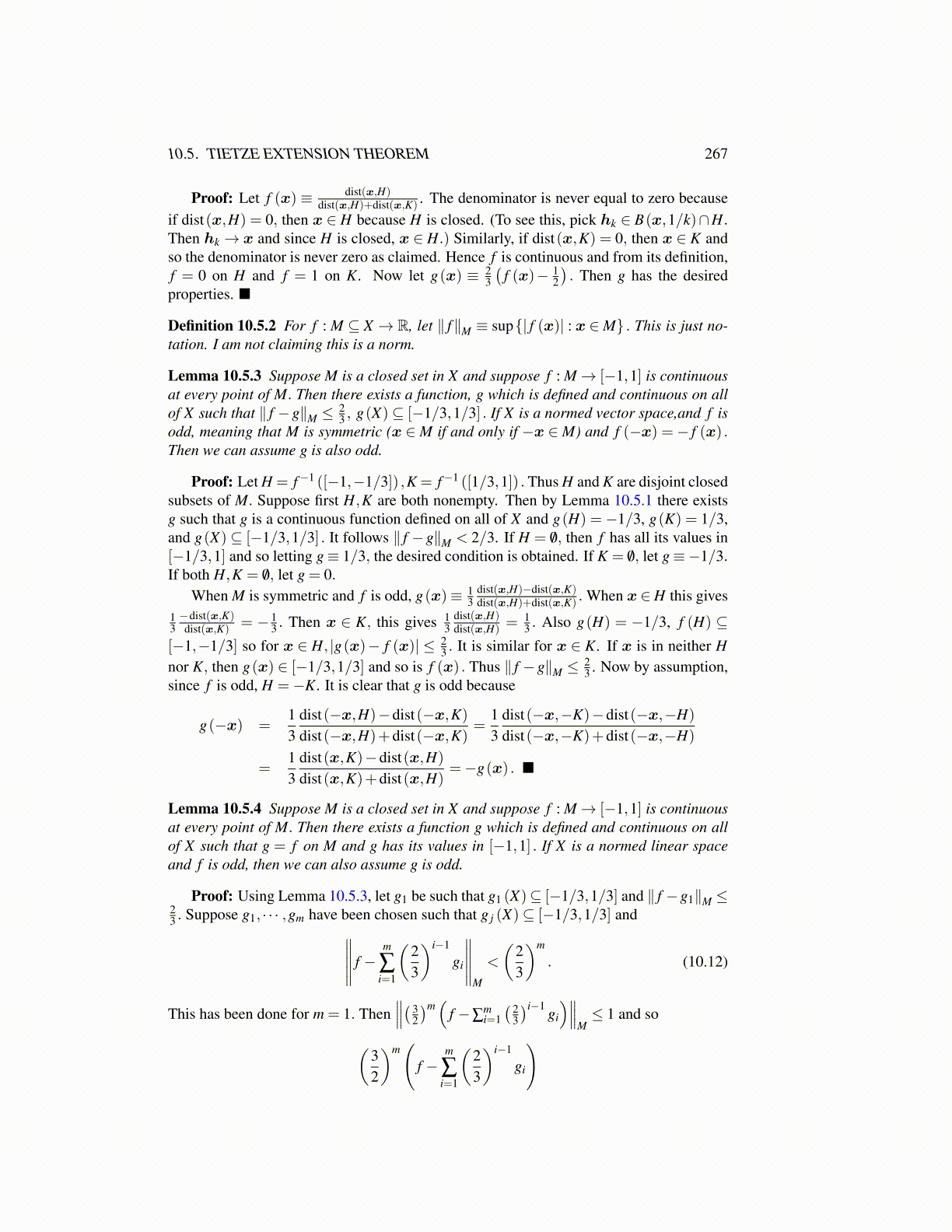
10.5. TIETZE EXTENSION THEOREM 267
Proof: Let f (x) ≡ dist(x,H)dist(x,H)+dist(x,K) . The denominator is never equal to zero because
if dist(x,H) = 0, then x ∈ H because H is closed. (To see this, pick hk ∈ B(x,1/k)∩H.Then hk → x and since H is closed, x ∈ H.) Similarly, if dist(x,K) = 0, then x ∈ K andso the denominator is never zero as claimed. Hence f is continuous and from its definition,f = 0 on H and f = 1 on K. Now let g(x) ≡ 2
3
(f (x)− 1
2
). Then g has the desired
properties. ■
Definition 10.5.2 For f : M ⊆ X → R, let ∥ f∥M ≡ sup{| f (x)| : x ∈M} . This is just no-tation. I am not claiming this is a norm.
Lemma 10.5.3 Suppose M is a closed set in X and suppose f : M→ [−1,1] is continuousat every point of M. Then there exists a function, g which is defined and continuous on allof X such that ∥ f −g∥M ≤ 2
3 , g(X)⊆ [−1/3,1/3] . If X is a normed vector space,and f isodd, meaning that M is symmetric (x ∈M if and only if −x ∈M) and f (−x) = − f (x) .Then we can assume g is also odd.
Proof: Let H = f−1 ([−1,−1/3]) ,K = f−1 ([1/3,1]) . Thus H and K are disjoint closedsubsets of M. Suppose first H,K are both nonempty. Then by Lemma 10.5.1 there existsg such that g is a continuous function defined on all of X and g(H) =−1/3, g(K) = 1/3,and g(X)⊆ [−1/3,1/3] . It follows ∥ f −g∥M < 2/3. If H = /0, then f has all its values in[−1/3,1] and so letting g≡ 1/3, the desired condition is obtained. If K = /0, let g≡−1/3.If both H,K = /0, let g = 0.
When M is symmetric and f is odd, g(x)≡ 13
dist(x,H)−dist(x,K)dist(x,H)+dist(x,K) . When x ∈H this gives
13−dist(x,K)dist(x,K) = − 1
3 . Then x ∈ K, this gives 13
dist(x,H)dist(x,H) =
13 . Also g(H) = −1/3, f (H) ⊆
[−1,−1/3] so for x ∈ H, |g(x)− f (x)| ≤ 23 . It is similar for x ∈ K. If x is in neither H
nor K, then g(x) ∈ [−1/3,1/3] and so is f (x) . Thus ∥ f −g∥M ≤ 23 . Now by assumption,
since f is odd, H =−K. It is clear that g is odd because
g(−x) =13
dist(−x,H)−dist(−x,K)
dist(−x,H)+dist(−x,K)=
13
dist(−x,−K)−dist(−x,−H)
dist(−x,−K)+dist(−x,−H)
=13
dist(x,K)−dist(x,H)
dist(x,K)+dist(x,H)=−g(x) . ■
Lemma 10.5.4 Suppose M is a closed set in X and suppose f : M→ [−1,1] is continuousat every point of M. Then there exists a function g which is defined and continuous on allof X such that g = f on M and g has its values in [−1,1] . If X is a normed linear spaceand f is odd, then we can also assume g is odd.
Proof: Using Lemma 10.5.3, let g1 be such that g1 (X)⊆ [−1/3,1/3] and ∥ f −g1∥M ≤23 . Suppose g1, · · · ,gm have been chosen such that g j (X)⊆ [−1/3,1/3] and∥∥∥∥∥ f −
m
∑i=1
(23
)i−1
gi
∥∥∥∥∥M
<
(23
)m
. (10.12)
This has been done for m = 1. Then∥∥∥( 3
2
)m(
f −∑mi=1( 2
3
)i−1gi
)∥∥∥M≤ 1 and so
(32
)m(
f −m
∑i=1
(23
)i−1
gi
)